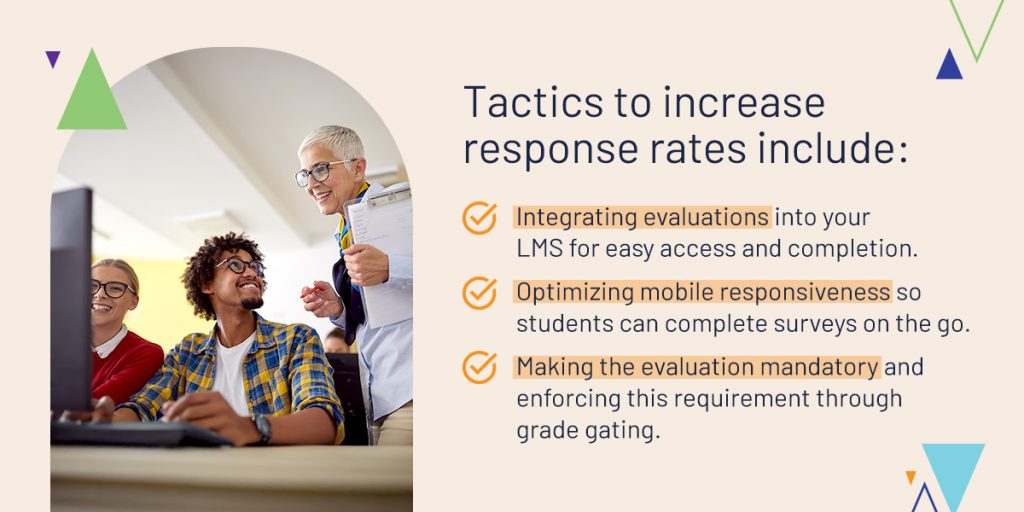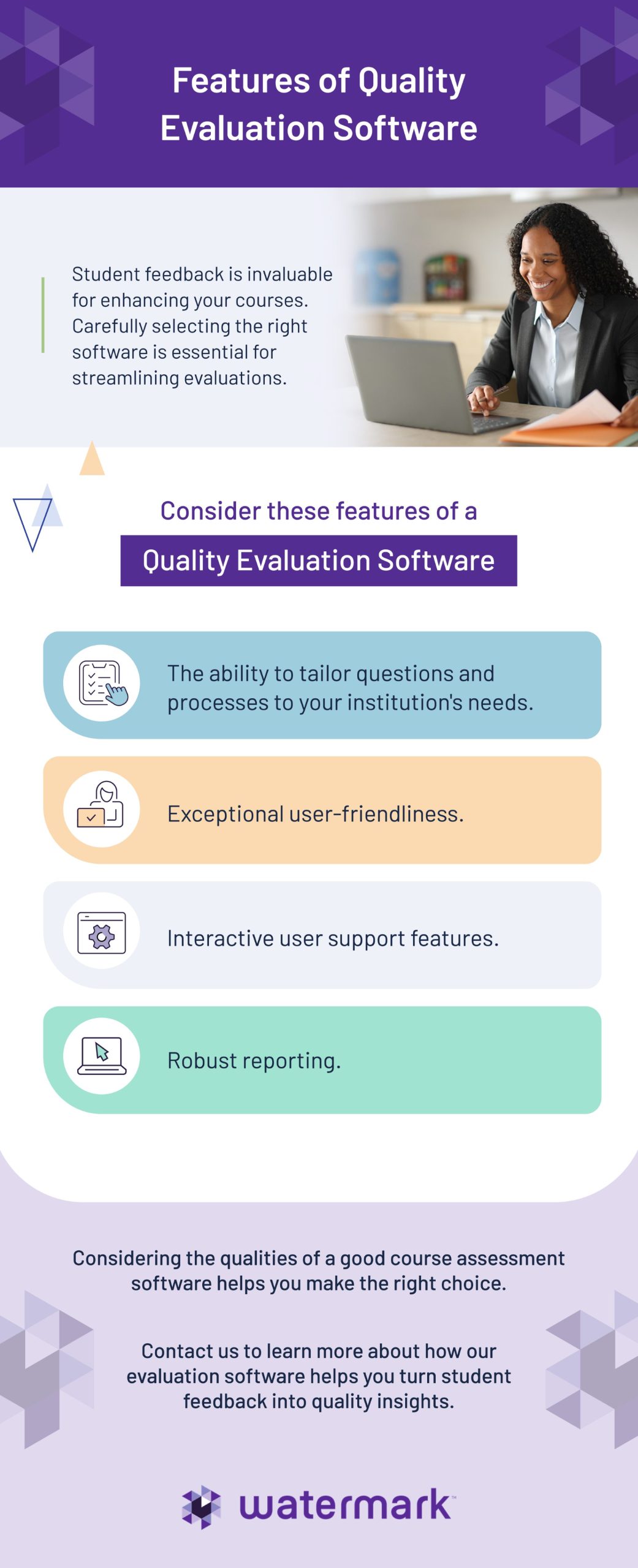
Course evaluations are part of the semesterly and annual rhythm of life at most higher education institutions. But despite the efforts administrators invest in course evaluations, few institutions leverage the full potential of student surveys. Accreditation is one area where course evaluations are an underappreciated but invaluable resource.
Your institution is probably already investing resources into course evaluations. This guide will help maximize your return on investment (ROI) by explaining how course evaluations can become an asset for achieving and maintaining accreditation.
The impact of course evaluation on accreditation
Accreditation and course evaluation are related in several ways. Course evaluations can assist with achieving and maintaining accreditation by:
- Demonstrating continuous improvement: Most accreditation bodies include continuous improvement among their accreditation standards. One semester after another, course evaluations tell a story of your institution’s commitment to continuous improvement. Comparing survey data from one semester or year to the next can show that your institution has identified growth opportunities and made progress in those areas.
- Enhancing instruction quality: Survey feedback helps instructors refine their teaching methods, classroom management, program content, and use of educational technology to meet student needs. For example, if a question about career readiness elicits feedback that students feel underprepared for practical skill applications, lecturers can incorporate more practical work in classes.
- Improving assessments: Accreditation standards often prioritize assessments as key program components. For instance, standards may specify that assessments should come with transparent learning outcomes, be free from bias, and help students check or improve their grasp of the content. Course evaluation questions can help reveal how effective assessments are and how well they align with accreditation standards from a student perspective.
- Evaluating learning objective relevance: Students know their own goals best and often pay close attention to how well their learning experience serves those goals. Student surveys can help measure, improve, and demonstrate how relevant program learning objectives are to industry opportunities.
- Informing administrative decisions: Faculty administrators can use course evaluation data to inform strategic decisions about curriculum planning, faculty development, and resource allocation. These data-driven decisions enable progress in key areas for accreditation.
- Supporting student success: Student surveys can highlight areas where students need additional resources and support to succeed. Identifying and addressing these needs can help improve student outcomes, which is essential for achieving and maintaining accreditation.
10 tips to optimize course evaluations for accreditation
With a clear understanding of how course evaluations can support accreditation processes by driving, detecting, and documenting conformity to standards, you’re well-positioned to optimize surveys for these purposes.
1. Frame questions around accreditation standards
Your question selection has the greatest impact on the feedback you’ll receive. To maximize the feedback’s value for accreditation, ensure the questions relate to accreditation standards. Sample questions to use for common accreditation standards include:
- Learning objectives: Did you receive a clear breakdown of this program’s learning objectives and outcomes in the first session?
- Curriculum quality: On a scale of 1-10, how well did the curriculum equip you to understand the subject matter?
- Teaching quality: To what extent did the lecturer explain the concepts in a way you could understand and apply?
2. Incorporate questions about improvement
Most accreditation bodies include continuous improvement in their standards. To check whether your institution’s commitment to growth is clear from a student perspective, include questions about how your faculty strives to improve their teaching, enhance the curriculum, and respond to student concerns.
3. Collaborate on survey design
Like program development, survey design benefits from diverse perspectives. Engage faculty, student representatives, community members, and other stakeholders in the survey design process. Invite them to suggest questions, expose biases, and propose improvements.
4. Protect confidentiality
Students are most likely to provide honest and constructive feedback when confident that their anonymity is safe. Develop a confidentiality policy ensuring administrators and faculty will not and cannot access a student’s personal information from their responses. Communicate this commitment to students through written statements and verbal assurances. Course evaluation and survey software can automate confidentiality safeguards.
5. Prioritize response rates

A larger pool of feedback is more likely to reflect the experience of most students and provide accurate insights. This makes response rates a KPI of how well your evaluation process supports accreditation. Tactics to increase response rates include:
- Integrating evaluations into your learning management system (LMS) for easy access and completion.
- Optimizing mobile responsiveness so students can complete surveys on the go.
- Making the evaluation mandatory and enforcing this requirement through grade gating.
6. Elicit quality responses
Along with response rates, quality feedback is vital for achieving and maintaining accreditation. To help students provide the information you intend your questions to discover, you need to frame those questions strategically. This could involve:
- Using straightforward language and defining terms where necessary.
- Screening survey questions for unconscious bias.
- Employing multiple types of questions to target the same information, including yes/no, Likert scale, and open-ended questions.
7. Document questions and responses as evidence
Record surveys and student responses to document your institution’s conformity to accreditation standards and its commitment to continuous improvement. Reports summarizing survey response data are helpful evidence to include in accreditation self-studies.
8. Implement feedback
One of the best ways of encouraging students to invest time into evaluations is showing them how the feedback drives real changes. Commit to implementing constructive feedback by making the necessary improvements to the curriculum, teaching methods, support resources, and other areas. Then, preface each round of surveys by pointing to tangible improvements that previous evaluations prompted.
9. Review and improve evaluation design
Consider having administrators, teaching faculty, student representatives, and other stakeholders meet regularly to review survey questions and the evaluation process. These reviews can explore how well evaluations support accreditation and the desired standards of teaching quality and student success. Commitment to this cycle of evaluation, review, and improvement reflects the institutional growth mindset accreditation bodies look for.
10. Use evaluation and accreditation software
Innovative course evaluation and accreditation software tools can streamline the survey process and help optimize it for supporting accreditation. Look for functions like:
- Accreditation application workspaces that allow institution-wide collaboration and progress monitoring.
- Survey response data reporting to provide insights for improvement and evidence for accreditations.
- LMS integrations to simplify survey completion and increase response rates.

Leverage evaluation data for accreditation with Watermark Course Evaluations & Surveys
Gathering, analyzing, and implementing course evaluation feedback is a complex process. However, that feedback is a priceless resource for institutions seeking to achieve and maintain accreditation. Watermark Course Evaluations & Surveys makes accessing data-driven insights to support accreditation simpler than ever.
This innovative higher education software solution allows administrators and faculty to:
- Boost response rates through LMS integration, reminders, grade gating and other features.
- Access, analyze, and report feedback to drive accreditation progress.
- Access our full Educational Impact Suite (EIS), including our accreditation management and self-study software.
Request your free demo of Watermark Course Evaluations & Surveys today.

































































































































































































































































































































































































